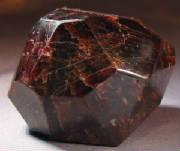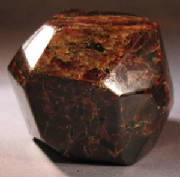|
Garnet Spheres, Wands, Etc.
By the term 'garnet', the specialist understands a group of more than ten different gemstones of similar
chemical composition. It is true to say that red is the colour most often encountered, but the garnet also exists in various
shades of green, a tender to intense yellow, a fiery orange and some fine earth-coloured nuances. The only colour it cannot
offer is blue. Garnets are much sought-after and much worked gemstones - the more so because today it is not only the classical
gemstone colours red and green which are so highly esteemed, but also the fine hues in between. Furthermore, the world of
the garnets is also rich in rarities such as star garnets and stones whose colour changes depending on whether they are seen
in daylight or artificial light.
Garnet has a hardness of 7 to 7.5 on the Mohs scale. With a few minor exceptions
it applies to all the members of the garnet group, and it is the reason for the excellent wearing qualities of these gemstones.
Garnets are relatively insensitive and uncomplicated to work with. The only thing they really don't like is being knocked
about or subjected to improper heat treatment. A further plus is their high refractive index, the cause of the garnet's great
brilliance. The shape of the raw crystals is also interesting. Garnet means something like 'the grainy one', coming from the
Latin 'granum', for grain. This makes reference not only to the typical roundish shape of the crystals, but also to the colour
of the red garnet, which often puts one in mind of the seeds of a ripe pomegranate. In the Middle Ages, the red garnet was
also called the 'carbuncle stone'. And even today, fantasy names like Arizona ruby, Arizona spinel, Montana ruby or New Mexico
ruby are still rife in the trade.
|
|

|
| Click on photo to enlarge in new window. |
|
Huge polished garnet crystal from India. Approx. size: 65x53x48 Approx. weight: 355 grams

|
| Click on photo to enlarge in new window. |
|
|
|